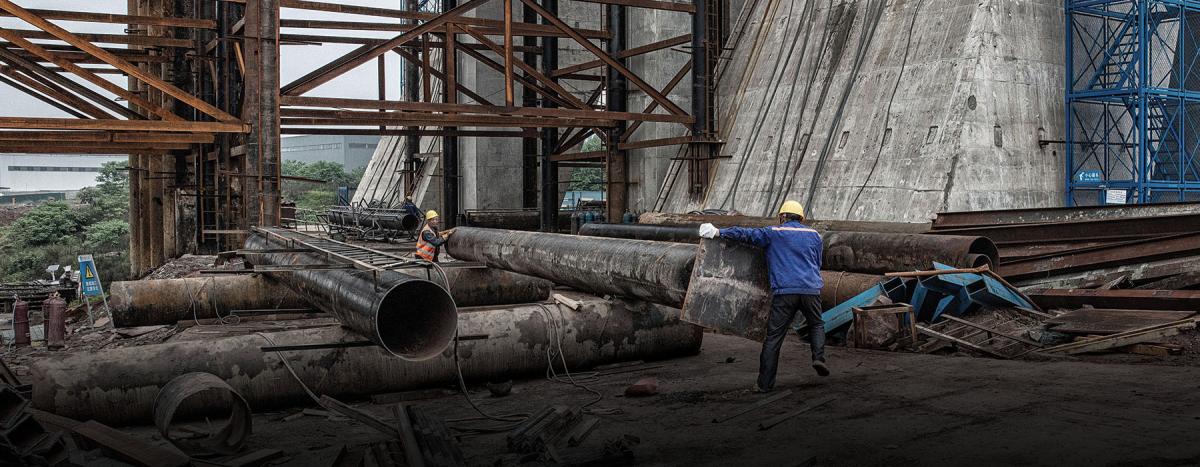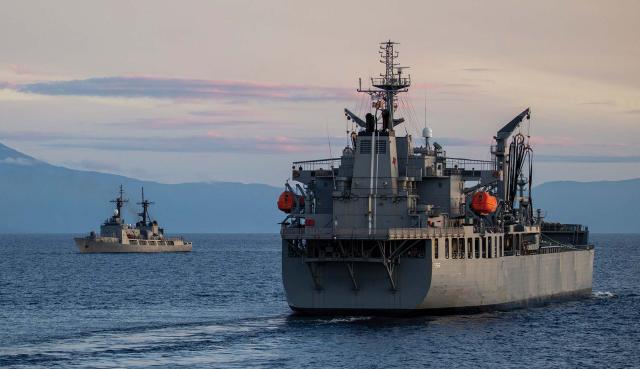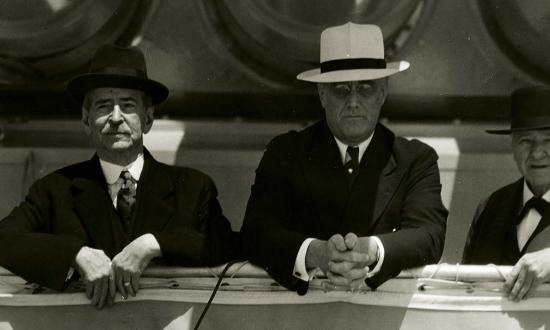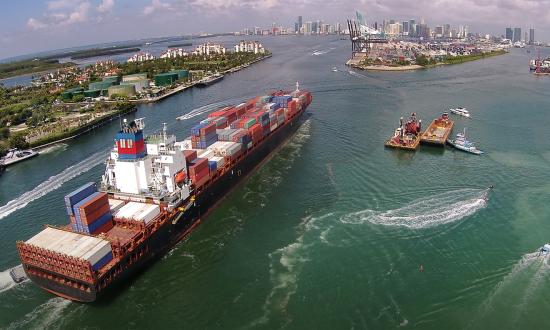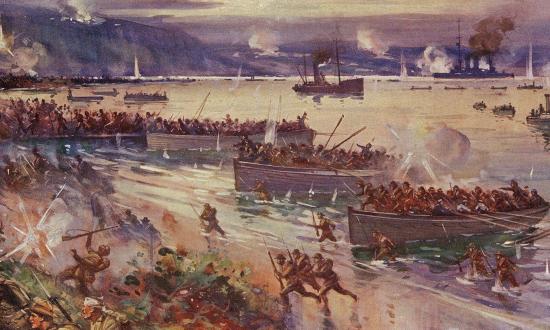The Indo-Pacific region is the central front in the new Sino-American cold war. What started 30 years ago as a slowly evolving and comparatively low-key peacetime military competition centered on Taiwan has grown in intensity and scope and is now playing out across the vast arc that extends from the Japanese home islands, down through the narrow straits of Southeast Asia, and then west to the Persian Gulf and the east coast of Africa. If war comes, this is where it is likely to break out and where it will be fought. With land-based forces in supporting roles, the outcome of such a struggle will be determined by what happens on, over, and under the surface of these waters.
Geopolitically, the United States finds itself in the familiar position of trying to rally a coalition of mostly democratic nations along the Eurasian periphery to counterbalance the growing strength of an aggressive, authoritarian, continental power. There are some obvious differences with the past, however. In contrast to the Cold War, most current and likely future U.S. partners in this new rivalry are insulated either by water or by significant terrestrial barriers from the territory of their potential opponent. In the event of war, such circumstances should favor the defense—but they also may complicate efforts to organize and hold together a countervailing coalition that might be able to deter war. When thousands of miles of open ocean separate the potential members of such a grouping, it can be harder to persuade the members to agree in advance that an attack on one should be regarded as an attack on all.
Cold War with Chinese Characteristics
For the Soviet Union, as for Imperial and Nazi Germany, sea power was optional rather than essential. Indeed, the belated pursuit of substantial naval capabilities proved to be, at best, a wasteful diversion and, at worst, an alarming provocation to wary rivals.1 China’s situation is obviously different. Since the start of “reform and opening up” in the late 1970s and early 1980s, the nation’s explosive economic expansion has propelled it into the world in search of technology, capital, markets, and investment opportunities. Trade remains the essential engine of China’s growth, and the vast majority of its trade travels by sea. In short, China today is a great power because it has become a seafaring nation.
China’s turn to the outside world and its growing dependence on maritime commerce coincided with the end of the Cold War, the collapse of the Soviet Union, and the start of a period in which the United States enjoyed unchallenged command of the seas. The confluence of these developments created a vulnerability of which Chinese naval strategists and political leaders were painfully aware, but about which—at first—they could do very little. U.S. power, especially naval power, also stood in the way of Beijing achieving its regional goals of absorbing Taiwan and asserting its maritime claims in the East and South China Seas. Despite these dangers, in keeping with its overall strategy, the Communist Party regime chose, in Deng Xiaoping’s words, to “hide its capabilities and bide its time,” relying on the prospect of mutual economic gain to check the aggressive impulses of the United States and its allies while taking advantage of the opportunities presented by the West’s engagement to build up all the elements of its own comprehensive national power.
Since the early 1990s, People’s Liberation Army (PLA) planners have sought to develop weapons and operational concepts with which to counter any future U.S. effort to project power into the western Pacific.2 Beijing has put in place an extensive antiaccess/area-denial (A2/AD) complex: a combination of reconnaissance systems and conventional precision-strike weapons capable of targeting fixed bases and mobile platforms at ever-increasing ranges from China’s coasts. These are backed by, among other things, antisatellite and cyber capabilities designed to disrupt U.S. and allied command and control, an integrated air-defense system to protect the Chinese mainland, and a modernizing, mobile nuclear force meant to deter potential attackers while broadening the array of options available to China’s leaders. Beijing also has used unconventional means creatively, building islands and deploying a sizable seaborne militia to strengthen its position and assert its maritime claims.
All this activity is clearly intended to deter U.S. intervention in a possible future conflict off China’s coasts and to delay and defeat it should deterrence fail. In the long run, Beijing evidently hopes to “win without fighting,” undermining the credibility of U.S. security guarantees, weakening its alliances, and clearing the way for China to resume its rightful place as the preponderant power in eastern Eurasia.
Trade and Risk
Starting around the turn of the century, China’s leaders and military strategists began to look beyond their immediate neighborhood and contemplate the implications of becoming a global power. The nation’s economy grew even faster after its entry into the World Trade Organization in 2001, driving demand for imports of ever-increasing volumes of oil, minerals, and agricultural products. These cargoes virtually all arrived by ship, many of them traveling from parts of the “global South,” especially Africa and the Persian Gulf. Around this time, China also began to encourage the practice of “going out,” urging Chinese companies to invest a portion of the nation’s fast-accumulating supply of foreign exchange in mines, farms, factories, and other assets in the developed and the developing worlds.
China’s burgeoning involvement in the global economy fueled its growth and put more resources at the disposal of its leaders, but it also heightened feelings of vulnerability. Reflecting these concerns, in 2004 President Hu Jintao charged the PLA with responsibility for fulfilling the “new historic mission” of protecting China’s now far-flung interests.3 More pointedly, Hu also expressed anxiety about the so-called Malacca Dilemma—the fact that a large portion of the nation’s imports, and especially its imports of energy, must pass through narrow straits in Southeast Asia, rendering them susceptible to interdiction by the navies of the United States and its allies.4
Beijing’s response to these dangers has consisted of several interlocking parts. The investments the regime has made over the past two decades in trans-Eurasian pipelines, roads, and railways sometimes appear irrational when assessed in purely economic terms. Under normal peacetime conditions, ships can carry far greater volumes of cargo much more cheaply. In the event of conflict, however, overland links could provide a vital lifeline, potentially enabling the delivery of enough energy and raw materials to keep a wartime economy running.
Similarly, many of the ports and other facilities China has bought or built along the maritime axis of Xi Jinping’s much-touted Belt and Road Initiative appear to be operating at a loss and may never turn a profit.5 Control of these logistical hubs could nevertheless ensure that, in a crisis, China-bound cargo (much of it carried on vessels built, owned, and operated by Chinese state-owned enterprises) would receive top priority. Some of the facilities springing up around the rim of the Indian Ocean also could eventually handle visiting naval vessels and military aircraft.
Finally, in addition to infrastructure, Beijing has begun to invest in the kinds of ships, planes, air-mobile and marine ground force units, logistics, and communication systems it will need to project power thousands of miles from home. With more aircraft carriers, nuclear-powered submarines, and underway replenishment vessels planned, the PLA Navy (PLAN) is on its way to becoming a true blue-water navy and could be moving toward building a dedicated Indian Ocean fleet.6
Security Dilemma at Sea
Whereas China’s capabilities in the Pacific are already quite mature and their intended purpose clear, the opposite is true in the Indian Ocean. The PLAN may have the capacity to evacuate civilians and conduct counterpiracy patrols off Africa. But it still is not ready to project significant increments of force ashore to intimidate or support local governments, still less to inflict a decisive defeat on the navy of a peer competitor such as India, to say nothing of going toe-to-toe with the United States. While less capable forces may be useful for a variety of purposes and for less extreme contingencies, unless and until it can acquire such strength, Beijing cannot be confident of its ability to secure its sea lines of communication to South Asia, the Middle East, and Africa.
Even if, from Beijing’s perspective, its aims are purely defensive—preventing Taiwan independence, preparing to break a blockade of China’s coast, guarding maritime claims against encroachment by other states, and protecting trade and investments around the Indian Ocean—its actions in pursuit of these ends cannot help but appear deeply threatening to the interests of the United States and its allies. In this sense, at least, the two sides are locked in something resembling a classic security dilemma, in which each side’s efforts to enhance its own security intensifies the other’s feelings of insecurity. Of course, what constitutes a defensive posture is in the eye of the beholder. The United States and its regional partners believe preserving the status quo is essential to their security; China’s leaders are equally convinced the survival of their party and nation depends on its revision.
If the Chinese Communist Party regime can fulfill its long-standing promise to “reunify” Taiwan with the mainland, it will have achieved multiple goals simultaneously: snuffing out a second Asian democracy (after Hong Kong), thereby removing a living refutation of its claim that self-government is not suitable for Chinese people; demonstrating its own iron resolve and irresistible power while calling into question the value of U.S. security commitments; and seizing or destroying industrial and technological assets that would otherwise contribute to the strength of its rivals. Taking control of Taiwan also would help clear a path through the first island chain, making it easier for the PLAN to surge into the western Pacific to engage the fleets of its enemies and threaten the sea lines of communication running north to South Korea and Japan.
If it can enforce its maritime claims against those of its neighbors, Beijing will be able to control use of the natural resources of the East and South China Seas. Having the capacity to regulate traffic through the South China Sea also would enable the regime to apply diplomatic pressure, and perhaps to inflict economic pain, on its Northeast Asian neighbors. At a minimum, it could compel U.S. ships and others to take longer, costlier routes to reach their destinations. Similarly, if China acquires the ability to interdict shipping and dominate choke points at either end of the Indian Ocean, it would be in position not only to threaten India, but also to disrupt commercial flows to and from Western Europe, as well as East Asia and the United States.
Ultimately, if Beijing can undermine U.S. alliances in East Asia, push U.S. forces back to the second island chain, and assert control over the waters of the western Pacific, it will be well-positioned to construct a new Eurasian order. What China’s strategists evidently have in mind is a Sino-centric system in which its continental and maritime neighbors are economically dependent on China and politically subordinate to it, and from which the Unites States is largely excluded.7 Should this come to pass, U.S. access to the world’s most dynamic region would be limited, harming its future growth; its long-standing alliances would likely be dissolved, constraining its ability to project military power; and the prospects for the future spread and perhaps even the survival of liberal democratic values and institutions in Asia would dwindle, damaging their luster and lending credence to Beijing’s claim that its authoritarian system represents the wave of the future. For its part, China would have gained a secure base from which to project power into other parts of the world, perhaps including the Western Hemisphere. It is worth recalling that the United States fought two world wars and waged a 40-year Cold War to ensure no hostile Eurasian power could attain such a position of regional preponderance.
Win with Fighting, if Necessary
China’s leaders obviously would prefer to achieve their objectives in the Indo-Pacific through the incremental accumulation of positional advantages and without the costs and risks of a direct clash of arms. But they also are acquiring the forces and developing the doctrine they believe will give them the best chance of winning, should war become necessary. Unfortunately, Beijing’s preparations are pushing it toward a posture in which the chances of success would depend heavily on preemption.
In the western Pacific, China is building the capabilities necessary to carry out massed conventional precision strikes on the bases, forces, and reconnaissance and communication systems of the United States and its regional allies. The PLA’s theory of victory appears to envision a first strike that would effectively knock the United States out of the theater in the opening stages, accompanied by the seizure of key maritime terrain and establishment of a defensive perimeter along the first island chain, after which Beijing would presumably depend on economic suasion and threats of escalation to bring U.S. allies to terms and to discourage Washington from continuing the war.8
At least for now, China’s Indian Ocean posture will remain quite fragile. Any forces deployed there at the start of a conflict would risk being cut off if the United States and its allies can control the narrow straits around the Indonesian archipelago. Without marked improvements in defensive capabilities, PLAN surface ships would be vulnerable to attack by missiles and torpedoes, while its submarines would be susceptible to being tracked and targeted. Whatever bases or dual-use facilities support China’s presence in peacetime would likely not survive the early stages of a war against a major power.9
On the other hand, if Chinese forces can get in the first blow, they might be able to do serious damage to the ships and facilities of the United States and its partners, attacking commercial shipping, temporarily closing major choke points such as the Suez Canal, and perhaps compelling the shift of some U.S. forces from the Pacific to the Indian Ocean. It stands to reason that PLA planners should prefer, if they are going to lose forces in the secondary theater, to use them first. It follows that, if they are going to initiate hostilities in the Pacific, China’s leaders will have strong incentives to do so simultaneously in the Indian Ocean.
To judge by official statements, it is not yet clear how the United States and its allies and partners propose to deal with these rapidly evolving challenges. While some parts of a possible countervailing strategy have been discussed and seem to have gained widespread acceptance, important questions remain (publicly) unanswered. First, general agreement exists on the importance of trying to achieve deterrence by denial, building forces and command networks that, through some mix of mobility, dispersal, deception, and active and passive defenses, can survive an initial strike, blunt the accompanying offensive, and prevent China from rapidly achieving its initial objectives. Failure could enable Beijing to impose a fait accompli, leaving few good options in response and possibly creating pressure for nuclear escalation.10
Second, rough consensus has emerged regarding the desirability of deploying many long-range antiship and antiaircraft missiles to islands along the first island chain and using these, presumably in combination with submarines and antisubmarine warfare capabilities, to complicate the PLAN’s efforts to move into the open waters of the Pacific. This is an important part of the motivation behind the Marine Corps’ Force Design 2030, and Japanese defense planners have also embraced the idea.11
Some academics have made the case for essentially stopping here, building a network of U.S. and allied A2/AD systems that mirrors China’s, albeit on a smaller scale, and adopting a purely “defensive defense” posture.12 Advocates argue that such an approach would be less expensive, less provocative, and less prone to escalation than the alternatives. Although the idea is appealing in many ways, there are reasons to be skeptical that, in itself, a maritime Maginot Line would be sufficient to deter aggression or to bring a war to a successful conclusion. If PLA planners were confident that the United States and its allies would forgo strikes against targets in or close to China, they might believe they could wear down their opponents with repeated attacks, eventually punching holes in any defensive line. To degrade the PLA’s ability to continue to conduct offensive operations, and to impose costs that could compel its leaders to cease hostilities, the United States will likely need to maintain and possibly expand its ability to launch precision conventional attacks on targets inside China.13
If, despite their best efforts, allied forces fail to deny China its initial objectives, political leaders will demand options other than capitulation or catastrophic escalation. Maritime blockade will be high on the list of possibilities. Civilian U.S. analysts differ widely on the feasibility and impact of various types of blockade; military professionals have, for the most part, been notably silent.14
Despite Western ambivalence, Beijing’s investments in alternative transportation routes, commercial shipping capacity, overseas port facilities, and, recently, in a blue-water navy suggest that Chinese planners take the possibility of a blockade very seriously indeed. Building and exercising the kinds of forces that would make this threat even more credible could therefore help to bolster deterrence. It might also have an impact on how the Chinese regime allocates scarce national resources, encouraging it to spend more on uneconomical infrastructure projects and to invest more in domains of military competition (such as undersea warfare and long-range power projection) where it lags behind and the United States and its allies can expect to continue to enjoy a significant advantage. As U.S. naval strategists ponder how best to deter and, if necessary, fight and win a future war in the Indo-Pacific, they also need
to think about how their choices may shape what is likely to be a protracted military rivalry with China.
1. See Andrew S. Erickson, Lyle J. Goldstein, and Carnes Lord, China Goes to Sea: Maritime Transformation in Comparative Historical Perspective (Annapolis, MD: Naval Institute Press, 2009).
2. CDR Michael Dahm, USN (Ret.), “China’s Desert Storm Education,” U.S. Naval Institute Proceedings 147, no. 3, (March 2021).
3. James Mulvenon, “Chairman Hu and the PLA’s ‘New Historic Missions,’” China Leadership Monitor, no. 27 (Winter 2009).
4. Ian Storey, “China’s ‘Malacca Dilemma,’” China Brief (April 2006).
5. Devin Thorne and Ben Spevack, Harbored Ambitions: How China’s Port Investments Are Strategically Reshaping the Indo-Pacific (Washington, DC: C4ADS, 2017).
6. Christopher Colley, “An Indian Ocean Fleet?” War on the Rocks, 2 April 2021.
7. Nadège Rolland, China’s Eurasian Century: Political and Strategic Implications of the Belt and Road Initiative (Seattle, WA: National Bureau of Asian Research, 2017).
8. Ashley Townsend, Brendan Thomas-Noone, and Matilda Steward, Averting Crisis: American Strategy, Military Spending and Collective Defence in the Indo-Pacific (Sydney, Australia: United States Study Centre, August 2019).
9. Toshi Yoshihara and Jack Bianchi, Seizing on Weakness: Allied Strategy for Competing with China’s Globalizing Military (Washington, DC: Center for Strategic and Budgetary Assessments, January 2021).
10. See Mike Gallagher, “State of (Deterrence by) Denial,” Washington Quarterly 42, no. 2 (Summer 2019): 31–45.
11. Yoji Koda, “China’s Blue Water Navy Strategy and Its Implications,” Center for a New American Security, March 2017.
12. See, for example, Eugene Gholz, Benjamin Friedman, and Enea Gjoza, “Defensive Defense: A Better Way to Protect U.S. Allies in Asia,” Washington Quarterly 42, no. 4 (Winter 2020): 171–89, and Jonathan D. Caverley and Peter Dombrowski, “Cruising for a Bruising: Maritime Competition in an Anti-Access Age,” Security Studies 29, no. 4 (2020): 671–700.
13. See Aaron L. Friedberg, “An Answer to Aggression,” Foreign Affairs (September/October 2020): 150–64.
14. See Sean Mirski, “Stranglehold: The Context, Conduct and Consequences of an American Naval Blockade of China,” Journal of Strategic Studies 36, no. 3 (February 2013): 385–421; Gabriel Collins, “A Maritime Oil Blockade against China—Tactically Tempting But Strategically Flawed,” Naval War College Review 71, no. 2 (Spring 2018): 49–78; and Fiona S. Cunningham, “The Maritime Rung on the Escalation Ladder: Naval Blockades in a US-China Conflict,” Security Studies 29, no. 4 (2020): 730–68.



